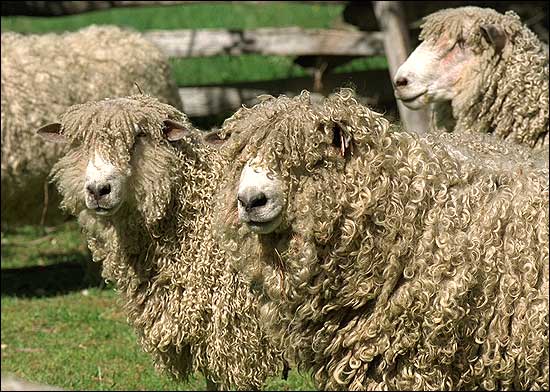Type the name of the breed you're looking for below
[wpdreams_ajaxsearchlite] Don't see the breed your're looking for? Click here and let us know!
Leicester Longwool sheep
| Place of Origin | England |
| Origin | The breed is also known by Bakewell Leicester, Dishley Leicester, English Leicester, Improved Leicester, Leicester, New Leicester.The Leicester Longwool is a sheep breed with a long and interesting history. They are currently found in the US, Great Britain, Australia and New Zealand. Development of the Breed: The breed was developed in the 1700's by Robert Bakewell. Bakewell was the first to utilize modern animal breeding techniques in the selection of livestock. Using these practices he developed the Leicester Longwool from the old Leicester sheep. His selection techniques changed a coarsely boned, slow growing Leicester into an animal that put on weight more rapidly and produced less waste when slaughtered. Robert Bakewell deserves recognition for his work with these sheep because it changed livestock farming forever and because it influenced the work of people such as Charles Darwin and Gregor Mendel. Since wealthy colonial farms often subscribed to these journals to keep up with the advances of the day, news of Bakewell's endeavors reached the thirteen colonies as well. George Washington was so interested in Bakewell's ideas that he made reference to him in several letters. In 1793 Washington wrote "...and the choice of good rams from the English [Leicester] breed which we now and then get over notwithstanding your prohibitory laws or customs." In 1837 the agriculturalist Youatt wrote "within little more than half a century the New Leicester had spread themselves over every part of the United Kingdom and to Europe and America." The Leicester Longwool were well known in the colonies and were used in the 19th and early 20th centuries created new breeds of sheep. They had almost disappeared from North America by the 1980's. In the early 1980's Colonial Williamsburg's Coach Livestock Department began a search for a breed of sheep that fit their 18th century mission. They began the search for an authentic breed of the 18th century by using primary documents of the time. Unfortunately, very few breed names appear in those papers, and the only Williamsburg reference is to a "lost Guernsey bull." Sheep, however, often appear on area inventories and wealthy farmers apparently subscribed to English farming publications to keep in touch with the latest practices and ideas. Eighteenth century farming literature was full of praise and accolades for a breed of sheep referred to by several names including "New Leicester, Bakewell Leicester, Dishley Leicester," and "Leicester Longwool." These were the sheep developed by Robert Bakewell on his farm called Dishley in Leicestershire, England. |
| Purpose | Meat, Fiber |
| Characteristics | The fleece is heavy, curly, soft handling and lustrous, with a spiral-tipped staple 200-250mm in length, 32-38 micron. The fleece generally weighs from 11 to 15 pounds with some weighing as much as 20 pounds. Leicester Longwool are generally described as a medium to large breed with a large, high quality carcass. |



